The Strange Case of ‘Telephone’
A closer look at the Lady Gaga/Beyoncé video—its origin story, its influences, its themes, and its legacy—on its 10th birthday
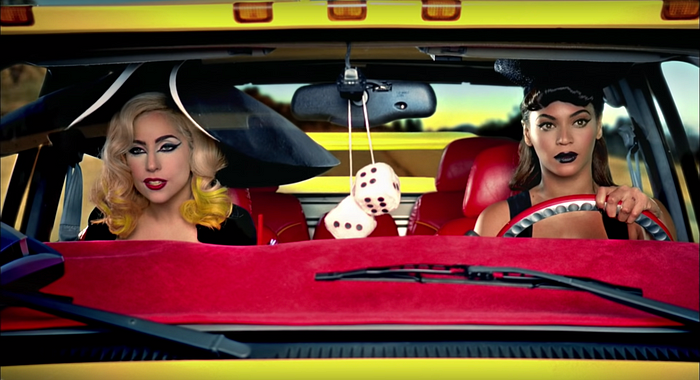
“I hate ‘Telephone.’ Is that terrible to say? It’s the song I have the most difficult time listening to.”
“Because it was offered to Britney first?”
“Well that’s not exactly what happened, but I don’t want to delve into that. I could delve into it if you turn that off,” said Lady Gaga, motioning to journalist Peter Robinson’s audio recorder.
It was May of 2011, the same month that the then 25-year-old star released Born This Way, and Robinson had asked her what she thought her worst song was. There weren’t too many to chose from yet—she’d technically only put out one album, The Fame (2008), and its reissue, The Fame Monster (2009)—but her answer was still unexpected. “Telephone” had been a standout track from The Fame Monster. It was nominated for a Grammy; it featured Beyoncé, another massive star; its video garnered half a million views in its first 12 hours on YouTube. “When I say it’s my worst song it has nothing to do with the song,” Gaga clarified. “Just my emotional connection to it.”
But elsewhere in the same interview, she indicated that it wasn’t just the song she had mixed feelings about: “I can’t even watch the ‘Telephone’ video. I hate it so much. Beyoncé and I are great together. But there are so many fucking ideas in that video and […] I wish I had edited myself a little bit more.” As for Beyoncé, we know practically nothing about what she thinks of “Telephone,” aside from the fact that she felt “very, very honoured to be a part of it” while on set. It’s perhaps telling, however, that she’s only ever performed the song live twice—once during her 2011 Glastonbury set, and once just a few days before that same set.
Therein lies the weird contradiction at the heart of “Telephone,” whose video premiered 10 years ago today. For Gaga, it was a weak link in her early videography. (She much preferred her subsequent video, “Alejandro,” which didn’t do quite as well on the forums.) For Beyoncé, it may have been an honour to be a part of it, but she’s never suggested that it meant any more to her than that. “Telephone” was a collaboration between two artists—23 and 28, respectively—who’d only met relatively recently, whose brands and fanbases could not have been more different, and who’ve never (not once!) shared the stage to perform the song. And yet, as Interview noted the morning after the video’s premiere, it had clearly been “an important event in gay bars and coffee shops worldwide, one that finally brought together two long-contentious fashionable tribes.”
It’s those two tribes—and not so much Gaga or Beyoncé—who are responsible for “Telephone” the myth. In the decade since the video’s release, they’re the ones who’ve turned it into a cultural touchstone, a queer classic, and a meme regarding its highly improbable sequel.
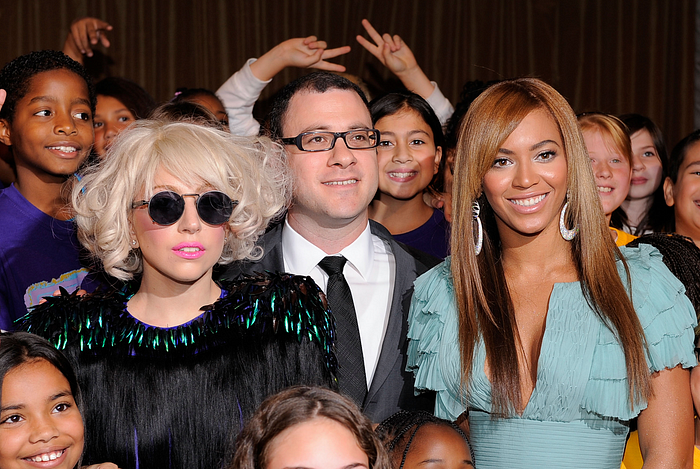
At the time of her breakthrough with The Fame in 2008, Gaga had already spent three years learning how the music industry worked from the inside. In between burlesque shows and music gigs played around New York City, the NYU dropout interned at Famous Music Publishing before later signing a songwriting deal with Sony/ATV. In the latter role, she wrote songs for everyone from Adam Lambert to Michael Bolton, but her most high-profile project was undeniably Britney Spears’s Circus (2008). (You can hear Gaga’s background vocals on “Quicksand,” a bonus track from the album.) “Telephone” was one of several songs penned for Britney’s use, and, according to Gaga, inspired by the pitfalls of her own work ethic:
[“Telephone” is about] fear of suffocation, or fear of never being able to enjoy myself because I love my work so much. I find it really hard to go out and just like… have a good time. And it’s because I usually go, and then a whiskey and a half into it, I start… ugh, I gotta go back to work. So that’s my fear: the phone’s ringing and my head’s ringing.
Though “Telephone” obviously didn’t end up on Circus, it was considered seriously enough that Britney recorded a demo. She and Gaga have since appeared on good terms, but whatever went down post-demo seemed to leave the latter a bit resentful of the song. And although she named “the mix and the process of getting the production finished” as the official reason why, her refusal to talk about Britney on the record was interesting.

At any rate, by the time Circus was released in November of 2008, Gaga had bigger things to worry about: The Fame had been out for three months, and “Just Dance” and “Poker Face” were slowly but surely working their way up the singles charts. Also released that November was Beyoncé’s third album, I Am… Sasha Fierce (IASF). The Fame and IASF (and the tours that supported both) kept Gaga and Beyoncé busy until the following September, when they officially met at the 2009 MTV Video Music Awards (VMAs)—the same night that Kanye interrupted Taylor and got yelled at by P!nk. Gaga was seated behind Beyoncé during the broadcast, and we know from photos that they interacted. Both women performed that night, both were nominated for nine awards, and both took home three in the end.
One week after the VMAs, Beyoncé released the eighth single from IASF, “Video Phone.” A week after that, her team suddenly recalled it. Beyoncé and Gaga had crossed paths once again at Billboard’s annual Women in Music luncheon on October 2, and the former had gotten the idea to put the latter on a remix of the song. Beyoncé called Gaga’s team—she was reportedly embarrassed to say “Lady Gaga” over the phone, which speaks to how new of an artist Gaga still was—and confirmed her interest/availability. The Gaga remix of “Video Phone” was released in November of 2009, accompanied by a frustratingly lo-res video by Hype Williams. All evidence suggests that Gaga was merely plunked into an existing video treatment, and with her own blessing: she supposedly told Beyoncé, “I want to do you in your video, and I want to tribute you. I want to dress up like you.”

It’s perhaps for this reason that behind-the-scenes footage from the set is more than a little cringeworthy. Surrounded by her usual team (including her diva fan) and with one prior Williams collaboration under her belt, Beyoncé’s very much at home. Gaga, on the other hand, has learned the choreography “yesterday.” She’s a good sport about it, laughing the hardest of anyone during playback at how mismatched they look. And then she says something that’s arguably crucial as far as “Telephone” goes: “That’s what’s fun, though. We can trade.” Sure enough, the day after “Video Phone” was released, so too was Gaga’s The Fame Monster, complete with “Telephone” (featuring Beyoncé). Given that the two women had only met for the first time in mid-September, it had to have been a last-minute addition to the album. (Aside from Gaga and Beyoncé, Rodney “Darkchild” Jerkins, LaShawn Daniels, and Lazonate Franklin are all credited as its writers.) In no more than two months, Gaga and Beyoncé had gone from total strangers to each scrambling to include the other person on a nearly-finished project. There was obviously tremendous commercial value in collaborating, but it’s also possible that Beyoncé was eager to swap her Sasha Fierce wig for a Bettie Page one. (She’d wear the latter for the remainder of the era’s videos, but more on that in a bit.)

“Telephone” received mostly praise from critics in reviews of The Fame Monster, officially kicking off the gruellingly long wait for a video. Gaga began stoking fan excitement in earnest in the last few days of December, when she shared that she was working on the treatment and pitching it to different directors. The job ultimately went to Jonas Åkerlund, who’d made “Paparazzi” the previous May. That video—Gaga’s longest and most daring up until that point—had ended with her poisoning her piece-of-shit boyfriend (Alexander Skarsgård, a friend of Åkerlund’s) and being taken to jail. “Telephone” would not only pick up where “Paparazzi” had left off but similarly concern itself with sex, violence, and infamy.
Like the song, Gaga’s concept for the “Telephone” video was inspired by her “fear of suffocation.” This time, however, that fear was funnelled through the idea of excess in American culture. The video was intended as a “commentary on being overfed, communication, and advertisements, and food in this country,” which is why it’s full of “American hallmarks, like with soda cans, and cigarettes, and mayonnaise, and bread.” As Gaga explained:
I wanted to […] take a decidedly pop song, which on the surface has a quite shallow meaning, and turn it into something deeper: the idea that America is full of young people that are inundated with information and technology and turn it into something that is more of a commentary on the kind of country that we are.
“She had a lot of ideas,” Åkerlund recalled in an interview last year. “Almost too many. I had to filter them and […] figure out how to [make] sense out of all of these ideas.” He got to work on making the treatment more manageable, if still convoluted. In the meantime, Gaga had lunch with Quentin Tarantino at his house and told him all about the concept. He “loved it so much” that he offered to loan her the Pussy Wagon from his Kill Bill films. (The car was originally set to be a convertible hearse.) As Åkerlund explained this week, “[Gaga] sent me a picture and said, ‘This is in Quentin’s driveway. Do we want it?’ And I was like, ‘Yeah! We want it.’ And I think it didn’t run or something, so we had to fix it up. And we fixed it up, and that’s why we ended up using it.” It was only then that the rest of the Tarantino nods—the red and yellow title cards, for instance—entered the picture. These changes were rather fitting in the end, since “Video Phone” had begun with an homage to Reservoir Dogs (1992).

By the end of January, Åkerlund had streamlined the concept: Beyoncé (or Honey B) would bail Gaga out of jail, Gaga would talk Honey B into poisoning her boyfriend (Tyrese Gibson) at a diner, they’d “by accident” poison all the other customers, and they’d flee the scene. (“What’s in your head, girl?” was reportedly Beyoncé’s first response to hearing the plan.) Sprinkled throughout the video would be dance sequences, an obscene amount of circa-2010 product placement, and several additional celebrity cameos. Production began on January 28, just after the single was sent to radio. The power dynamic from the “Video Phone” set had been flipped; it was now Beyoncé’s turn to be squeezed into another artist’s treatment. Åkerlund has confirmed that Beyoncé “wasn’t really part of developing the idea; she just showed up on [her] shoot day.” Behind-the-scenes photos suggest that she wasn’t given all that much time to learn her lines, either, and a recent viral tweet appears to show her sneaking a glance at them mid-take. In fairness to everyone involved, Åkerlund remembers being pressed for time, since both artists were currently on tour:
We shot that whole video in like two days. I remember they were rehearsing the dance choreography right before we were shooting it and we were supposed to do like some desert stuff with Beyoncé but the sun set so we couldn’t, so we put her in this motel room, which was completely improvised.
Thus concluded the “trade.” Once production had wrapped on the “Telephone” video, Beyoncé flew to Brazil to begin the South American leg of her I Am… World Tour. Gaga and Åkerlund went into the editing room, where they’d stay for, well, quite a bit longer than expected.

In early February, Gaga teased that the “Telephone” video would be even more impressive than “Bad Romance,” which had come out back in November (about a week prior to “Video Phone”). The former’s release was tentatively scheduled for February, but the editing process was made complicated by the fact that Gaga was touring. Andres, one of several people I got to DM with about “Telephone” in the last few days, clearly remembers the suspense: “The build-up online went for weeks, especially after it was delayed back a month. Everyone was aware that this thing was big—like the pop event of the year big.” To keep fans at bay, Gaga’s team periodically released stills from the video. Then, on March 11, “Telephone” finally premiered on E! News and Vevo, the latter of which had only existed since December.

Among everything else, one of the biggest talking points following the premiere was how patently and unambiguously gay the video was. (It was also rightly and thoughtfully criticized for its depiction[s] of transness.) Several people I DM’d with used the word “camp” while describing it; the common internet joke is that “LGBT” stands for “Lady Gaga & Beyoncé—Telephone.” Jai Rodriguez, best known for co-hosting the original Queer Eye, appears as the on-air correspondent who covers the mass homicide. Gaga kisses another woman (Heather Cassils) in the prison’s exercise yard before the two-minute mark, a moment that wasn’t planned. “I wasn’t instructed to kiss her,” Cassils has said. “But I felt that the most inappropriate thing to do”—and ‘inappropriate’ was the direction that she’d been given—“was to sniff her, kiss her and get up in her space. It surprised me that she put her tongue in my mouth first.” Kanika, who watched “Telephone” for the first time on Canada’s MuchMusic in the ninth grade, found herself particularly drawn to these prison scenes. “It felt intimidating, but also exciting,” she said. “Especially for someone who was just realizing that they liked girls, too, and didn’t know what to do with that.” For Zack, who watched the video on an iPod Touch at 15, the video was formative to his coming of age as a gay man:
At the time, I was adamantly not a Gaga gay […]. I didn’t get her, I didn’t wanna be seen as too effeminate by liking her, and I thought a lot of her act was just that. […] This was the video that led me to finally listen to all of “The Fame Monster,” and it was then that I really fell in love with her and everything she stood for. To me, “Telephone” […] represents me stripping away one of the layers of my own internalized homophobia. I grew up in north Texas, and while my coming out wasn’t nearly as difficult as it was for many of my peers, I still felt an unwarranted obligation, at times, to maintain some form of masculinity in myself that liking Gaga didn’t fall into. I think the shamelessness of the “Telephone” video, in a way, helped me come into my own shamelessness.
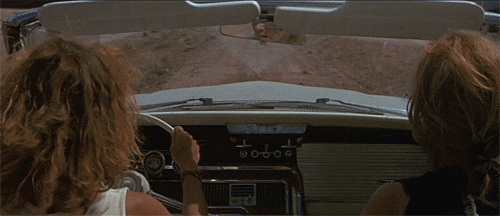
One of the video’s more interesting references is to Ridley Scott’s Thelma & Louise (1991), a film that’s come to be known in part for its “lesbian subtext” (if you can call it that). “Telephone” directly recreates one of the last shots of Scott’s film—in which the two leads clasp hands before driving off a cliff—for its own penultimate shot. Gaga and Honey B don’t get to kiss before the clasp like Thelma and Louise, but they do at least get to live afterwards. The lesbian subtext of “Telephone” (arguably actual subtext, in this case) didn’t go unnoticed by Kaiya:
I remember being 12 and questioning my sexuality for the first time and noticing that Gaga and Beyoncé looked like more than friends in the video, and I realized that even though it was a fictionalized version of the two women, that women being more than friends was okay.
By the end of the one-two punch of “Paparazzi” and “Telephone,” Gaga and Honey B have both literally murdered their boyfriends so that they can drive off into the desert holding hands—pretty gay, all things considered. But while Gaga ascended to fame in the late aughts as an out bisexual, Beyoncé is in some ways one of our most aggressively straight pop icons. As Kaiya said, “Beyoncé being perceived to be in a relationship with another woman is a striking image because, while I do view her as a ‘gay icon’ of sorts, her sexuality has never had an aura of speculation around it.” For some people, the fantasy of imagining Beyoncé—someone whose brand has been built largely around her real-life heterosexual union, warts and all—in a more-than-friends relationship with Gaga has been a major part of the video’s appeal.
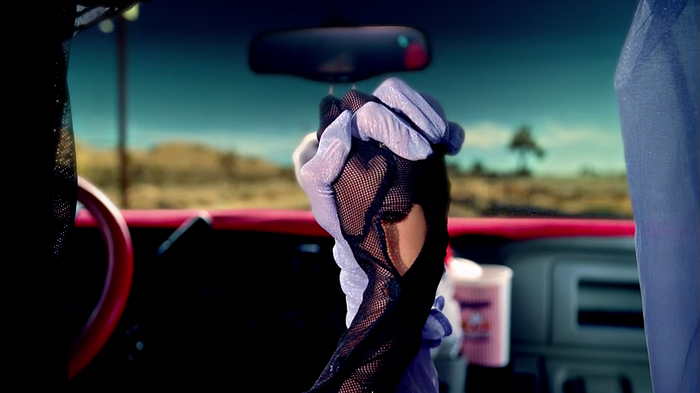
The video ends with a To be continued… that’s responsible for surely thousands of social media posts regarding a possible sequel. Åkerlund revealed this week that he and Gaga “started to write” one at an unspecified time, but scrapped it in the end. Realistically, the odds of us getting a continuation of the story at this point are slim to none; if I’m ever proven wrong, my bet is that it won’t feature Beyoncé. It might be best, however—and I realize that this is an unpopular opinion—to leave “Telephone” alone, since the video’s strength arguably lies in its singularity, not to mention its many unanswered questions. To continue the story as ‘promised’ would make too much sense for a video that’s dazzlingly non-sensical.
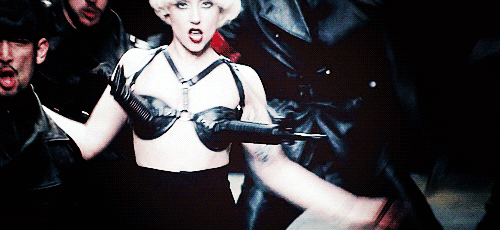
After “Telephone,” Gaga got to work on “Alejandro,” her favourite of the two videos. She then continued her Monster Ball Tour for another year, eventually wrapping things up in May of 2011. That brings us back to where we started, with Gaga confessing her ‘hatred’ for “Telephone.” Respectfully but frankly, it didn’t really matter what Gaga thought of the video anymore; it belonged to the fans now. It would also ultimately have bigger implications for Beyoncé.
For all her commercial success during the IASF era, we know now that Beyoncé struggled both creatively and personally towards the end of it. The concept behind the two-disc concept album—one disc representing Beyoncé; the other representing her alter ego, Sasha Fierce—had fallen flat with a lot of people. She was also still managed by her father, Mathew Knowles, who in early 2010 was not only putting her mother through hell but potentially stealing money from Beyoncé’s tour. Though it’s unclear when exactly this next part happened, she also suffered a miscarriage sometime around “Telephone.” (While very pregnant with Blue Ivy in late 2011 or early 2012, she vlogged about being “pregnant for the first time” about two years prior. That would’ve been late 2009 or early 2010—exactly when she was collaborating with Gaga.)
In January of 2010, Beyoncé announced that she’d be taking a career hiatus once her tour was over in March. This interview with since-disgraced reporter A.J. Calloway—given two weeks before the “Telephone” video premiered—is revealing as to how badly she needed it. She’s visibly frustrated when Calloway grills her about the family she wants to (and was privately trying to) have someday; she tells him, without much humour, that she’s “killed” Sasha Fierce. “Telephone” was one of the last things Beyoncé did before she disappeared “to live life, to be inspired by things again.” When she returned the next year, she’d fired her father and recorded the bulk of her next album, 4 (2011), which pointed to her self-actualization as an artist. Beyoncé’s collaboration with Gaga in 2010 had taken place on the cusp of a major image change: the former may have been the one to make the initial call to the latter two weeks after watching her bleed on stage, but she’s also the one whose swearing is bleeped out even in the explicit version of “Telephone.”

In 2016, Wesley Morris argued of “Telephone” that Gaga had “invited Beyoncé into the world of the surreal, which she has yet to leave.” Gaga actually echoed this closer to the video’s release: “It was sort of a pop-art venture for me to bring her into my world. […] It was something for me to kind of change the way that you see her for one video.” Beyoncé, who’d never worked with Åkerlund before 2010, has now worked with him twice as many times as Gaga has, and often for edgier projects (“Haunted” from her 2013 self-titled album, the On the Run Tour: Beyoncé and Jay-Z HBO special, etc.). “Telephone” did indeed change the way that we saw Beyoncé for one video, and she’d evidently liked that.
I’ve highlighted Gaga and Beyoncé’s ambivalence and relative silence about “Telephone,” respectively, not to detract from the video in any way, but to illustrate just how important their fans have been to creating and sustaining its myth. A decade ago today, two distinct—sometimes even quarrelsome—fanbases came together to enjoy a nearly 10-minute music video event, and have since turned it into a pop-cultural phenomenon. “Telephone” is what fandom can be at its best.
If you enjoyed this essay, you might also enjoy my newsletter.
